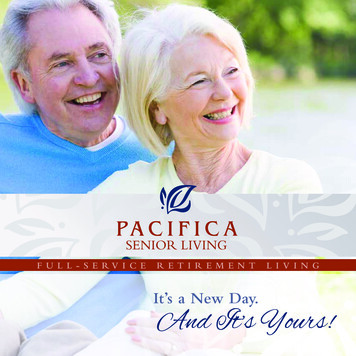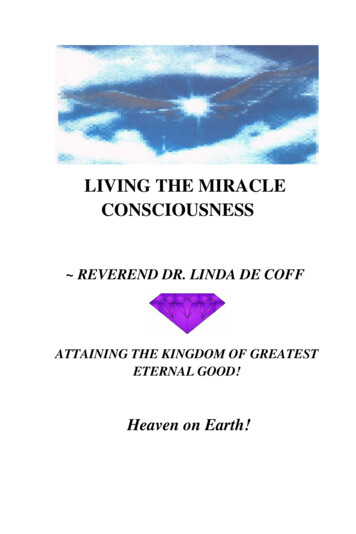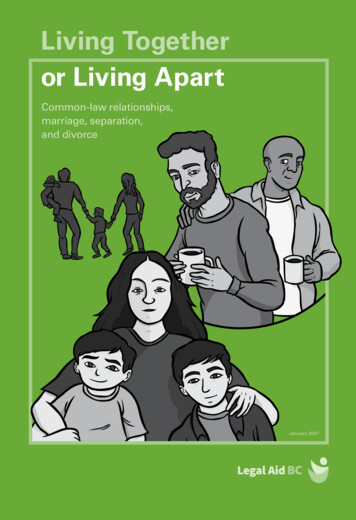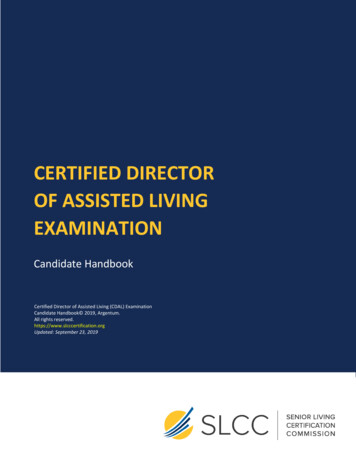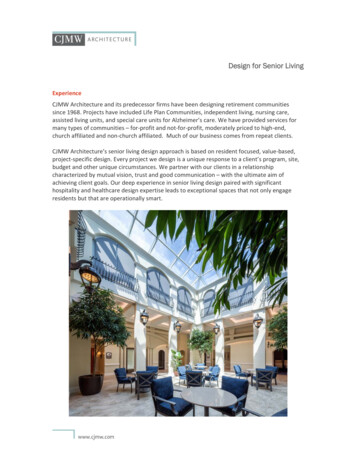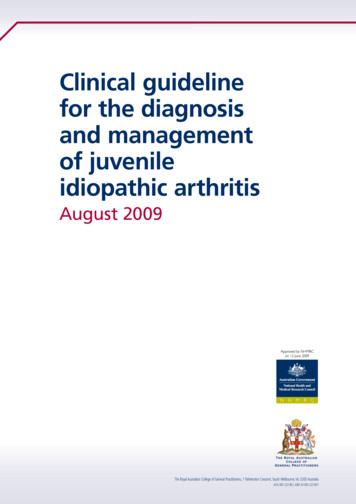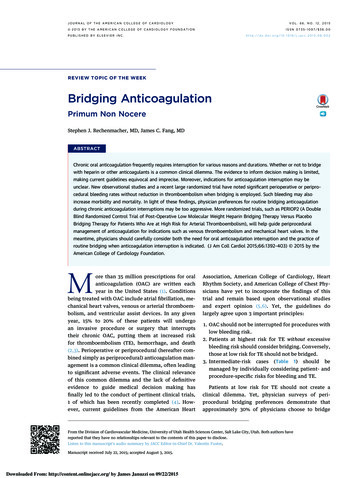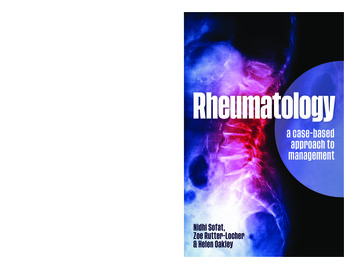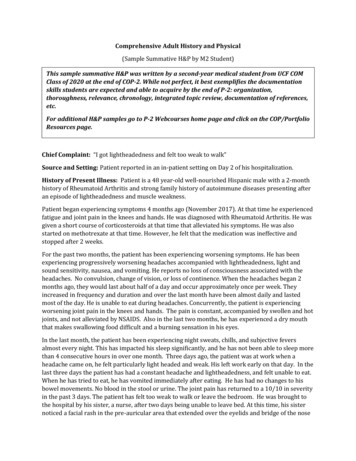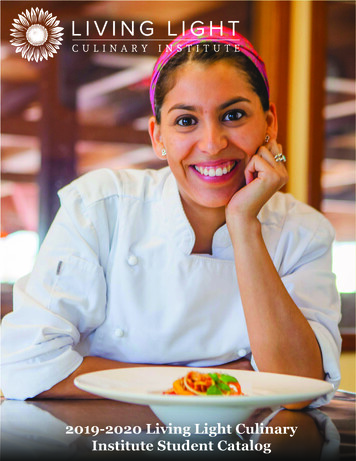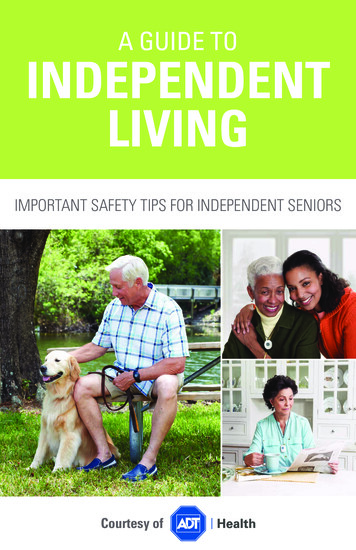
Transcription
EDGAR STENE PRIZE 2016ISSN 2306-4706 (Online)Living with a rheumatic ormusculoskeletal disease –How I take action toenjoy life to the fullENTERStanding Committee of People with Arthritis/Rheumatism in Europe (PARE)2016
EDGAR STENE PRIZE 2016Living with a rheumatic or musculoskeletal disease – How I take action to enjoy life to the fullContentsIntroductionAbout Edgar Stene and competition rules 2016Meet the 2016 JuryWinning essay 2016 from the United KingdomSecond place essay from EstoniaThird place essay from LatviaSelection of essays 2016:Belgium eet the other XITThe European League Against Rheumatism (EULAR) is the organisationrepresenting the patient, health professional and scientific societies ofrheumatology of all the European nations. EULAR endeavours tostimulate, promote, and support the research, prevention, treatmentand rehabilitation of rheumatic and musculoskeletal diseases (RMDs).Within EULAR, the national organisations of people with RMDs acrossEurope work together and develop activities through the StandingCommittee of PARE. For more information please visit www.eular.orgSTENE PRIZE BOOKLET 2016EULAR Vice President, representing PARE Marios KouloumasPARE Standing Committee Chairperson Dieter WiekEULAR Secretariat Maria Batziou, Birte Glüsing, Florian KlettEditor Kate BetteridgeCo-ordinator Birte GlüsingGraphic Designer and Print Production FC-D Ltd, LondonPublisher EULAR Standing Committee of People with Arthritis/Rheumatismin Europe (PARE)Number of copies – 1000The Standing Committee of PARE would like to thank all those who havecontributed to this publication.PREVIOUSNEXTPAGE 2
EDGAR STENE PRIZE 2016Living with a rheumatic or musculoskeletal disease – How I take action to enjoy life to the fullEarly diagnosis and access to treatment are key toenabling people with RMDs to live life to the fullIt is a pleasure and honour to have been asked to write the introductionto one of EULAR’s most important and valued publications – the 2016Edgar Stene Prize Booklet. The series started in 2009 and I am delightedto present a new and refreshed design to our readers with this 8thedition. I am proud to share it – not only is it popular within our owncommunity, but it is also highly valued by policy makers and other keystakeholders at the national and European level.This year’s topic was titled “Living with a rheumatic or musculoskeletal disease – How Itake action to live life to the full”. We have received contributions from 20 memberorganisations, and it was great to hear that this topic has been highly popular at thenational level. The large number of contributions is very encouraging as it shows that itis possible for many people to live a full life despite suffering from a chronic disease.For the first time EULAR is not only awarding a single winner but also officially thesecond and third ranking essays, which is a great achievement. For me though, allthose who have participated are winners and have my admiration. They have showna lot of courage in sharing their personal story, dreams and feelings with the world.Their honesty, vulnerability and humour makes it possible to relate to them at a verypersonal level, and I have been deeply touched.As a rheumatologist, I find it most rewarding to play a role – together with my team– in helping my patients to get their lives back. This was the reason why I chose thisprofession in the first place. Many of the essays tell how the most important stepon this path is to quickly get the right diagnosis in order to start treatment as soonas possible. But we know that it often takes too long to receive the correctdiagnosis in most countries in Europe. People suffer unnecessarily and are nottreated appropriately – thus, valuable time is lost. This is damaging to the individualon a personal level and to the healthcare systems. For some conditions, likerheumatoid arthritis, there is evidence that, if treated early enough, the otherwisesevere disability can be prevented and the person affected can also continue tocontribute economically to society.EARLY DIAGNOSIS AND ACCESS TO TREATMENT ARE KEYTO ENABLING PEOPLE WITH RMDS TO LIVE LIFE TO THE FULLHOMEPRINTEXITWe have some powerful treatments available today, but access is oftenoverregulated and, in some countries, extremely limited. We need to makedecision-makers understand that prevention, early diagnosis and access to theappropriate treatments save costs in the long term. These essays show us, in apowerful way, what really matters to people with RMDs and what issues needaddressing most urgently.EULAR is, of course, addressing these important areas in many of its existingprojects and campaigns. We will be fighting for early diagnosis – together with firstand secondary prevention – over the coming years, as it is vital to improve the finaloutcomes. EULAR offers a platform to all those who share this vision – for thosewho want to see a better quality of life for people with RMDs and to enable themto live their life to the full. It is the engine driving EULAR’s work, but it needs to berecognised and acted upon at the national and European level by politicians, keydecision-makers and society.I would like to sincerely thank all those who have participated in the competition forsharing their personal approach to how they live their lives – how to cope with thediagnosis, the daily pain, the barriers, the fatigue and many other challenges. I wasimpressed by their positive attitude, strength and joy for life despite the burden oftheir RMDs.I am sure that their great insight and knowledge will be shared widely and will helpall of us to improve the quality of life for the more than 120 million people livingwith an RMD in Europe.Prof. Gerd-Rüdiger BurmesterEULAR PresidentPREVIOUSNEXTPAGE 3
Living with a rheumatic or musculoskeletal disease – How I take action to enjoy life to the fullEDGAR STENE PRIZE 2016The Stene Prize“A great promoter of co-operation between doctors,patients and community workers.”First awarded in June 1975 at the EULAR Congress in Helsinki, Finland, the EdgarStene Prize was created by EULAR to honour the memory of Edgar W Stene. Stenewas the founder and Secretary-General of the Norwegian Rheumatism Associationand himself a person with ankylosing spondylitis (Morbus Bechterew).Preparations to create the prize followed the establishment of a new EULARConstitution at the organisation’s General Assembly in Paris, 26 May 1973, whichbrought the “National Community Agencies active in the struggle against rheumaticdiseases” into EULAR. The creation of a Standing Committee for Community Agencies,today called the Standing Committee of People with Arthritis/Rheumatism in Europe(PARE), was put into practice at the same time as the Constitution.Professor J J de Blécourt from The Netherlands, the first elected EULAR Vice Presidentrepresenting PARE, said about the occasion: “We may speak of an historic moment inthe history of EULAR. The basic philosophy behind this development is the fight againstrheumatism can only be effective, efficient and extended when not only the doctors(rheumatologists) but also the ‘rest of the community’ take part in the work of EULAR(the management of the fight against rheumatism). This is a modern way of organisinghealth care, research, fundraising, patient care, education, public relations, etc.”Rules of the 2016 Edgar Stene Prize competitionEvery year, the Stene Prize is awarded to the person with a rheumatic ormusculoskeletal disease (RMD) submitting the best essay describing his orher individual experience of living with their condition. Competition details aredistributed to EULAR member organisations so they can run the competitionnationally. Member organisations select the best entry from their country to submitto the EULAR Secretariat for judging by the Stene Prize Jury.For 2016, entry was open to people with an RMD aged 16 years and over. Entries canbe submitted in the native language of the author as EULAR arranges to translatenational winning entries into English.The winner of the Edgar Stene Prize is announced by the EULAR Standing Committeeof PARE on the EULAR website and in its newsletter. The value of the first prize isEURO 1,000 and the award is presented at the EULAR Annual European Congressof Rheumatology. EULAR covers the cost of the winner attending the congress. Inaddition, EULAR will award the second best essay with EUR 700 and the third rankingessay with EUR 300.Edgar Stene was born in 1919 and was a police sergeant, a sailor and a mechanic.During World War II he served in the allied forces’ navy and it was then that the onset ofhis disease began. The symptoms of the disease worsened and his doctorrecommended hospitalisation, but he remained in his job because of the importance ofhis position as a ship’s mechanic. After the war Stene was involved in welfare work. Heplayed an important role in Scandinavian and international organisations, and receivedrecognition from the Norwegian King and the Swedish Federation Against Rheumatism,among others. Edgar Stene was “ a great promoter of cooperation between doctors,patients and community workers”.He advocated the union of people with rheumatic and musculoskeletal diseases(RMDs) in a specific organisation to provide a platform for effectively addressing theissues that concerned them. He also emphasised the importance of people with RMDshaving an active and positive attitude towards their condition and preparing themselvespsychologically and physically to face their challenges.THE STENE PRIZEHOMEPRINTEXITPREVIOUSNEXTPAGE 4
EDGAR STENE PRIZE 20161.Living with a rheumatic or musculoskeletal disease – How I take action to enjoy life to the full2.The Edgar StenePrize Jury 2016 –meet the judgesEach year, a panel of people withexperience or knowledge of rheumaticand musculoskeletal diseases (RMDs)has the honour of judging the annualEdgar Stene Prize competition. Thisyear we welcome our judges whorepresent the three pillars of EULAR,and who come from a number ofdifferent countries across Europe.3.They are joined by the Chair of theEULAR Standing Committee of Peoplewith Arthritis/Rheumatism in Europe(PARE) and the EULAR Vice President,representing PARE who oversee thejudging and offer guidance to theoverall process.6.4.1. Dieter Wiek, Chair, EULAR Standing Committee of PARE“I was an adolescent when I was diagnosed with a rheumatic disease. When you are confronted with thisdiagnosis, and are seriously ill, you feel your whole world is breaking apart. All your plans for the future vanish,while pain and despair mingle and mutually reinforce. You feel you are in a dead-end street.But with the competence of your doctors and your treatment team, and support from your family and friends, yourlife will soon look bright and positive again. Nowadays, new therapies enable a good outcome. You will developyour optimal treatment plan and adapt your activities and plans to the new circumstances. You will recognise theenormous chances where you can participate and be active.Life is wonderful and, in spite of a rheumatic and musculoskeletal disease (RMD), it is possible to live a richlyfacetted life. And that is exactly this year’s topic. It was great to read your very personal stories about how youshape and enjoy your lives to the utmost.I enjoyed reading your essays.”2. Marios Kouloumas, Vice President, EULAR, representing PARE“This year’s topic for the Edgar Stene Prize essay competition is very close to my heart. As a person living withrheumatoid arthritis (RA) for many years, I know first hand how important it is to take your life back – to control yourfuture, live independently, be socially active, participate within society and enjoy your life to the fullest.Living with an RMD is difficult because of the pain and other symptoms that often accompany the disease. It can beeasy to withdraw from life, feel isolated and, finally, fall into an endless circle of pain and despair. Hence, when livingwith a rheumatic disease, it’s important to focus on what you can do, and not on what you can’t do.It is also important to accept the new situation of living with an RMD. Sometimes this requires a change in the wayyou do things, your attitude and lifestyle, and retaking control and learning alternative – and new – ways to live lifeto the fullest despite the disease.This year’s competition has given people with RMDs across Europe the opportunity to share their success story withus. These essays will, I am sure, inspire and motivate all others, and also show that, with the appropriate support,people with RMDs can live a full life with dignity and quality.”7.5.MEET THE JUDGESHOMEPRINTEXITPREVIOUSNEXTPAGE 5
Living with a rheumatic or musculoskeletal disease – How I take action to enjoy life to the full3. Nele Caeyers, PARE Board member from Belgium and spokeswoman for ReumaNet, is Leader of the2016 Edgar Stene Prize Jury“As a child, I enjoyed being outside with friends, running, playing, camping I really did enjoy life to the full. And Iplanned to continue doing so, but along came lupus. All of a sudden things weren’t self-evident anymore. Hospitalvisits instead of visits to friends, medical check-ups instead of social check-ups, walking instead of running, hesitatinginstead of going all the way.But I soon realised I only had one life, just like anyone else. And I had a choice: disappearing or taking control againand looking for things I could still achieve and enjoy. Today, I can honestly say I enjoy my life to the full. My family, myfriends, my job and my voluntary work are precious to me.I am very happy with the theme of this year’s Edgar Stene Prize competition. It forces you to look back at your life andyour achievements. Maybe it confronts you with your limits, but, even more, it makes you aware of your abilities! Lifeis too valuable, too unique and, most of all, too short to not enjoy it to the full!I enjoyed reading all your stories and have been inspired by them.”4. Prof. Tadej Avcin, Slovenia, Chair of the EULAR Standing Committee on Paediatric Rheumatology“It has been my great pleasure and honour to serve as a member of the Edgar Stene Prize jury. This year’s topic isparticularly important as it highlights how to overcome the burden of the disease and enjoy life to the full. Working asa paediatric rheumatologist, I observe patients during the critical transition period to adulthood, when they areespecially vulnerable to the possible negative effects of their disease.EDGAR STENE PRIZE 2016It has been a great pleasure to be part of this jury and I enjoyed reading the essays from the different Europeancountries. I think that the theme for this year ‘Living with a rheumatic or musculoskeletal disease – How I take actionto enjoy life to the full’ has given us very different, inspirational stories. I read all the essays and they were allwonderful! I think they all have something inspirational and something that we should remember. I really enjoyed mytask as a member of the jury!As for myself, I think I enjoy life to the fullest by not letting my illness define me. Although you possibly cannot doeverything you want, you can still do a lot when making a few adjustments. There are so many people in the worldwho are willing to help you. I think that, except for all the pain, my disease has also brought me really good things.”6. Costas Ioulianos, Cyprus, President of cosmosrheuma , representing the EULAR Health Professionalsin Rheumatology“Firstly, I would like to say how proud I feel to be a member of the Stene Prize jury panel. As a clinical physiotherapist– and due to my frequent involvement with people living with RMDs – I have come to the conclusion that there is animperative need to involve the patient in all decisions concerning them and their life.Since we talk about multidisciplinary and patient-centered treatment, we should support this – and with our actions.The patient should be the group leader and must be actively involved in order to solve and manage their problems. Wehave an obligation to feel/understand everything concerning the patient.The problem is not only the disease, but all the other related problems that follow which have to do with the patient,their family, their occupation and, generally, their position in the broad community.Successful life stories by people with RMDs are always encouraging and inspirational for both patients and physicians.Positive information about living with the disease is particularly important for young people in order to develop andenjoy all aspects of their lives.By taking part in the judging panel I have gained a lot from the patients themselves – a fact which is the mostimportant element towards the success of our work.”Evaluation of the transition process from the perspective of young adult patients has revealed that counselling about theirfuture, living with the disease, is one of the major perceived deficits in clinical care. In this respect, real-life successstories of patients with RMDs are precious and can provide enormous inspiration for patients and their families.7. Kjerstin Fjeldstad, Norway, Board member of the Norwegian League Against RheumatismI really enjoyed being involved in the Edgar Stene jury. I have learnt, from the patient perspective, how to take actionand live a happy and productive life. Reading the essays was a remarkable experience and very inspirational for me.All of the essays were very well written and it is extremely hard to highlight only a few of them.”5. Wendy Olsder, Netherlands, Board Member of Youth-R-Well.com and representative of Young PARE“My name is Wendy and I’m 21 years old. I’m on the board of Youth-R-Well.com, the Dutch association for youngpeople with a rheumatic disease. I was diagnosed with juvenile arthritis when I was 14 years old. Currently I’mstudying Industrial Engineering and Management at the University of Groningen.MEET THE JUDGESHOME“It has been an honour to be a member of the Stene Prize jury and I have been inspired by the vision applicants havefor their lives. This year’s theme ‘Living with an RMD – How I take action to enjoy life to the full’ has given authors anopportunity to look at their lives and tell us how they have reached their personal goals. I enjoyed reading the essaysvery much.I am 61 years old and spondyloarthritis (SpA) has been my friend the last 30 years. I still work, and I do voluntary workas well. I become involved in the Norwegian League Against Rheumatism 30 years ago. I have been a board memberand leader in a different part of the organisation.I work at the Norwegian Labour and Welfare Administration. I work full time, but have one day off every weekfor rehabilitation.”PRINTEXITPREVIOUSNEXTPAGE 6
EDGAR STENE PRIZE 20162016Living with a rheumatic or musculoskeletal disease – How I take action to enjoy life to the full2015: ‘Making a Difference’ award winner for socialresponsibility at The University of Manchester, pictured withProfessor Dame Nancy Rothwell, Chancellor of the UniversitySTENE PRIZEWINNERA life without arthritiswouldn’t be my lifeSimon Stones is a 22-year-oldstudent and patient researchambassador. He is single andlives with his parents, both ofwhom have multiple rheumaticand musculoskeletal diseases.His home town is Bolton in theGreater Manchester area of theUnited Kingdom (UK).Simon Stones2016 Stene Prize winnerfrom United Kingdom“I have lived with juvenile idiopathicarthritis (JIA), hypermobility andfibromyalgia from the age of three, andhave helped to care for my mother whohas systemic lupus erythematosus (SLE)and osteoarthritis. I am currentlystudying a bachelor’s degree inbiomedical sciences, and hope to dopostgraduate research into child health.As a consumer health advocate, I advisethe UK’s National Institute for HealthResearch, and Arthritis Research UK ontheir paediatric rheumatology researchagendas. In addition, I sit on numerousstrategic and advisory panels for healthand social care initiatives in the UK,including the development of mobile apptechnology to promote self-managementin young people with JIA.2016: at EULAR PAREConference in Sofia, BulgariaAged 12: living with active arthritis andundiagnosed Crohn’s diseaseA LIFE WITHOUT ARTHRITIS WOULDN’T BE MY LIFE: SIMON STONES – UNITED KINGDOMI have recently supported thedevelopment of EULAR/PReS (PaediatricHOMEPRINTEXITRheumatology European Society)recommendations for transitional care inyoung people with RMDs, and I sit onthe EULAR Young PARE working group.I began to work with EULAR YoungPARE in 2015 to help give young peoplewith RMDs a voice in Europe. I was atthe annual congress in Rome when Ilearnt more about the Stene Prize anddecided to take part. I chose toparticipate to share my story of livingwith arthritis and to inspire other youngpeople to realise that they are capable ofachieving their dreams.”I don’t remember a daywithout arthritis being there.Always in the background Wherever you look, whateveryou do, it’s there. Having hadarthritis from the age ofthree, it’s hard to rememberwhat life used to be like.I had a fairly “normal” childhood. Itwasn’t like that of my friends in school,but it was all that I knew. Arthritis took itstoll on my young body, with constanthot, stiff and swollen joints. Life began toget much worse when I was prescribedPREVIOUSa new drug in 2000. For three solidyears, I would suffer at the receiving endof this medicine. Weekends consisted ofconstant nausea and vomiting. I neverexperienced days out with friends. Eventrips to the shops with my parentsresulted in me lying down in the carfeeling sick. I tried to explain this to mydoctors, but they didn’t fully appreciatethe impact of this medicine on my life– let alone the impact of the disease inits own right.“For the first time in yearsI felt like I was in control”Life was pretty rough. I would go toschool during the week on the dayswhen I could physically get out of bed. Iwas exhausted in the evenings andspent the weekends ill at home as aconsequence of the medicine. At theage of seven, what was the point in life?If having arthritis wasn’t bad enough, themedicine to “treat” it felt like apunishment. I told the doctors at thehospital that I would rather be stuck in awheelchair for life rather than take thatdrug. The light at the end of the tunnelhad disappeared and all glimmers ofhope seemed a million miles away.NEXTPAGE 7
Living with a rheumatic or musculoskeletal disease – How I take action to enjoy life to the fullA turning point in my life was in 2004when, at the age of 11, I was switched onto a new biologic medicine. It was amiracle. After just a week’s treatmentwith the medicine I was able to get out ofthe wheelchair and walk – without feelingsick, without agonising pain. It wasunbelievable. Although pain and fatiguewere there every single day, it was moremanageable than before. For the firsttime in years I felt like I was in control.“They had just igniteda spark within me!”As a consequence of my inability toperform sports as a child, I had neverbeen a huge fan of football! Instead, Ihad channeled my time and energy intolearning – into being academic. My aimwas to get to do my GCSEs (GeneralCertificates of Secondary Education)‡ –but not just to pass them, I wanted toget the best! This seemed like a distantgoal, and I was uncertain whether Iwould get there after having had to missso much time from school.In the years that followed, I wasdiagnosed with Crohn’s disease and, incombination with arthritis, I missed anadditional 12 months of school. As Ibegan to study for my GCSEs, so manypeople said it wasn’t worthwhile puttingmyself through this stress. Theysuggested that I should just get throughthe exams, accept whatever I got, andchoose a stress-free job that didn’t affectmy health. However, they didn’t realisethat they had just ignited a spark withinme, which was going to prove themwrong. Nobody ever tells me that I amincapable of achieving my dreams!With sheer drive and determination, Iwent on to study my GCSEs, pushingmyself to the extreme. Given all of thepushbacks in life, nobody was going tostop me now. In the summer of 2010, Iwas over the moon when I achieved 13GCSEs at grades A and A*. I then wenton to sixth form college where I studiedbiology, chemistry, and physics at A-Level,achieving A and B grades in 2012.It may not surprise you that, later in thatyear, I moved to the University ofManchester to study a degree inbiomedical sciences. It was something Ihad always been interested in but, moreimportantly, was an opportunity for meto give something back to society – tohelp the people living with rheumatic andmusculoskeletal diseases (RMDs).“I wouldn’t want tobe perfect”Going to university whilst living witharthritis, Crohn’s disease andfibromyalgia certainly comes with itschallenges – especially having had yourconfidence knocked out of you as ayoung person. As I have grown up, I’velearnt to appreciate the small things inlife – a loving family, great friends andembracing new experiences. Now, at theage of 22, I am in the final year of myundergraduate studies, and I amprojected to achieve a 1st class honoursdegree in summer 2016 – somethingA LIFE WITHOUT ARTHRITIS WOULDN’T BE MY LIFE: SIMON STONES – UNITED KINGDOMwhich was just a dream in years gone by.I have learnt to take life with a pinch ofsalt – on my good days I sometimes gomad and do as much as I can. Inevitably,I may suffer the day after – but, to me, itis worth it. I may not be perfect, but Iwouldn’t want to be perfect. I think itcan take a number of years for you toreach this acceptance “phase”, whereyou can live beyond the limitations ofyour condition. I am more than capableof achieving what my peers can achieve.If I want to do something, I will do it– why should I not? Taking your dailymedication, doing your exercises andhaving time out are part and parcel ofyour daily routine. You learn to adapt,and view all of the positives in a seaof negativity.My personal experiences haveencouraged me to help others living withRMDs, who have to deal with thesehorrendous conditions on a daily basis. Ido this in the hope that, one day, peoplewith RMDs will not have to endure thephysical, social and psychologicalconsequences of these diseases.For the past three years, I have built onmy experiences to become a patientresearch ambassador – campaigning for,and representing the voice of, youngpeople with RMDs at a local, nationaland international level. In doing so, I havemet many wonderful people and seensome amazing places around the world– something that I would never havedone if I didn’t have arthritis.EDGAR STENE PRIZE 2016“Every person with an RMDis a wonderful, capableand unique human being”Moreover, I have taken the decision tostudy for a PhD in the autumn of 2016.In doing so, I hope that I will be able tomake a difference, and empower youngpeople to realise their dreams, hold on tothem and achieve them – because everyperson with an RMD is a wonderful,capable and unique human being.Studying for a degree, advocating forpatients and living with an RMD can, attimes, leave you completely drained.But, funnily enough, I have never beenhappier. Life without arthritis wouldn’t bemy life – the one that I love. Myexperiences have shaped me into theperson I am today, and I would neverwant to change.Simon is now working to improve the livesof other young people with RMDsA life without arthritiswouldn’t be my lifeSimon StonesI live for today and dream for tomorrow.None of us know what is around thecorner but, when you learn to live the lifeyou love and love the life you live, you’vefound true happiness. I keep fighting, Ikeep smiling and I enjoy every moment inthis rollercoaster of a journey that is life.‡ Editor’s note: GCSE examinations are takenby most pupils at the end of compulsoryschool education (aged 16 years) in England,Wales and Northern Ireland.2012: receiving the ‘success and determination’award after leaving Sixth Form CollegeHOMEPRINTEXITPREVIOUSNEXTPAGE 8
EDGAR STENE PRIZE 2016Living with a rheumatic or musculoskeletal disease – How I take action to enjoy life to the full2016Life shouldn’t be sickly-sweetSTENE PRIZE2nd placeI am 31 years old, singleand live in Paide in Estonia.I work as head of planningand development in the JärvaCounty administration.I learnt about the Edgar Stene Prizefrom the EULAR website. The topicspoke to me and I decided to write anessay for the competition.Triin Pobbol2016 Stene Prize 2nd placefrom Estonia“Right, the blood test confirms mysuspicions about the diagnosis – youhave inflammatory polyarthritis,” mydoctor told me one February morning acouple of years ago. His voice wasmatter-of-fact. Like he was telling me thatmy shoelaces had come undone andneeded to be tied again. Or like drinkingmilk had given me a moustache thatneeded to be wiped off. He made itsound like something ordinary,something that happens every day. Butthe world inside me and around mecollapsed, and it took me a long time anda lot of effort to pick up the pieces again.I left the doctor’s in tears, knowing that Inow had a tedious friend I’d have to dragalong with me for the rest of my life.Denial and anger, not tomention accusationsAt an NBA Boston Celtichome game“I have polyarthritis?” I asked myself inthe days that followed. I have it, eventhough there’s no history of the diseasein my family. I have it, even though I’musually very careful about what I eat. Ihave it, even though I consider dailyexercise a very important part of my life.There were so many reasons I justI enjoy the outdoor life even if the weather is often wet in EstoniaLIFE SHOULDN’T BE SICKLY-SWEET: TRIIN POBBOL – ESTONIAThe shockHOMEPRINTEXITPREVIOUScouldn’t have this disease. I kept hopingthat they had mixed up the test resultssomehow and that the pain in my kneejoints was actually caused by somesmall trauma.Oh bloody hell, I thou
As a person living with rheumatoid arthritis (RA) for many years, I know first hand how important it is to take your life back – to control your future, live independently, be socially active, parti
